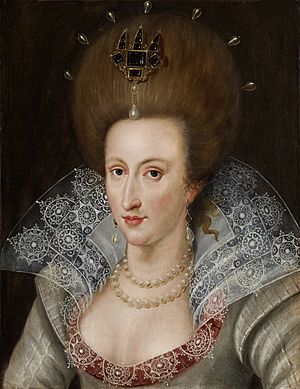James I of England facts for kids
Quick facts for kids James I |
|
|---|---|
 |
|
| Reign | 24 July 1567 – 27 March 1625 |
| Coronation | 29 July 1567 |
| Predecessor | Mary, Queen of Scots |
| Successor | Charles I |
| Reign | 24 March 1603 – 27 March 1625 |
| Coronation | 25 July 1603 |
| Predecessor | Elizabeth I |
| Successor | Charles I |
| Born | 19 June 1566 Edinburgh Castle, Scotland |
| Died | 27 March 1625 (aged 58) |
| Burial | 7 May 1625 Westminster Abbey |
| Spouse | Anne of Denmark |
| House | House of Stuart |
| Father | Henry Stuart, Lord Darnley |
| Mother | Mary, Queen of Scots |
| Religion | Protestant (Published the King James Version bible) |
| Signature |  |
James VI and I (born 19 June 1566 – died 27 March 1625) was a very important king in British history. He was King of Scotland as James VI from 1567. Later, in 1603, he also became King of England and Ireland as James I. This made him the first ruler to be called the King of Great Britain. He ruled both kingdoms until his death in 1625.
His time as king was special because it was the first time England and Scotland shared the same ruler. He was the first English king from the House of Stuart. Before him, Elizabeth I was the Queen of England. She had no children, so James, who was the son of Mary, Queen of Scots, became the closest relative to take the English throne. By ruling both countries, he created a "personal union," meaning the countries had the same king but kept their own separate governments.
James often had disagreements with the Parliament of England, which was the group of people who helped make laws. He also did not manage the kingdom's money very well. However, during his rule, the governments of Scotland and England were quite stable. After James died, his son Charles tried to rule in a similar way. But this led to the English Civil War, and Charles was executed in 1649.
Contents
Who Was King James I?
James was a very smart and educated person. He encouraged people in both England and Scotland to study subjects like science, literature, and art. He even wrote several books himself, including Daemonologie (about witches) in 1597, The True Law of Free Monarchies in 1598, and Basilikon Doron in 1599. One of his most famous achievements was supporting the creation of the Authorized King James Version of the Bible, which is still widely used today.
The Gunpowder Plot
James was the target of a famous plot called the Gunpowder Plot. A group of Catholics planned to blow up the Houses of Parliament on 5 November 1605. They wanted to do this during a ceremony when James would be inside the building.
However, the plot was stopped when one of the plotters, Guy Fawkes, was found in a basement with many barrels of gunpowder. This event is still remembered every year on 5 November, known as Bonfire Night. Many people celebrate by lighting bonfires and fireworks.
James also strongly believed in witchcraft. He even ordered all copies of a book called The Discoverie of Witchcraft to be burned because he disagreed with it.
English Settlements in America
King James played a role in the first English settlements in North America. In 1606, he gave a special document, called a charter, to Sir Thomas Gates and others. This charter allowed them to create the first permanent English settlement in North America.
James's Family Life
To make his rule stronger, James needed a good marriage. He chose Anne of Denmark, who was the younger daughter of the Protestant King Frederick II. They were officially married in Oslo on 23 November and returned to Scotland on 1 May 1590.
James and Anne had three children who grew up to be adults:
- Henry Frederick, Prince of Wales: He sadly died at age 18 in 1612 from a sickness called typhoid fever.
- Elizabeth
- Charles: He became king after James.
Queen Anne died in March 1619, before her husband.
His Later Years and Death
After he turned fifty, James started to have more health problems. He was often seriously ill during the last year of his life, which made it hard for him to visit London.
In early 1625, James became very ill in March and died at Theobalds House on 27 March. His funeral on 7 May was a very grand event. James was buried in Westminster Abbey. For many years, the exact location of his tomb was unknown. But in the 1800s, his lead coffin was found during an excavation in the vault of Henry VII.
Images for kids
-
James (right) depicted aged 17 beside his mother Mary (left), 1583. In reality, they were separated when he was still a baby.
-
James in 1586, age 20 (attrib. Adrian Vanson or the school of Alonso Sánchez Coello)
-
Suspected witches kneeling before King James; Daemonologie (1597)
-
Portrait after John de Critz, c. 1605. James wears the Three Brothers jewel, three rectangular red spinels; the jewel is now lost.
-
Portrait by Paul van Somer, c. 1620. In the background is the Banqueting House, Whitehall, by architect Inigo Jones, commissioned by James.
-
Robert Carr, 1st Earl of Somerset, by John Hoskins, 1625–30
-
On the ceiling of the Banqueting House, Rubens depicted James being carried to heaven by angels.
-
James I and his royal progeny, by Charles Turner, from a mezzotint by Samuel Woodburn (1814), after Willem de Passe
See also
 In Spanish: Jacobo I de Inglaterra y VI de Escocia para niños
In Spanish: Jacobo I de Inglaterra y VI de Escocia para niños















